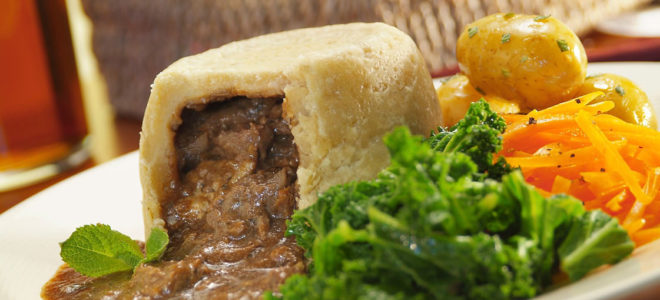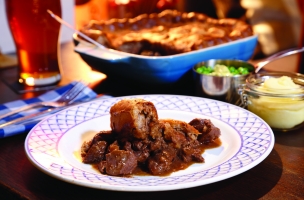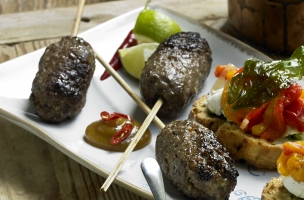
Lamb Suet Pudding served at The Farmer’s Cart Café
PREP TIME 1 hr * COOK TIME 2.5hrs Melt the butter with one tbsp. of oil in a large saucepan, over a low-medium heat. When the butter is foaming, add the shallots and garlic and cook for a few minutes until they begin to soften, but not colour. In a large bowl, mix tbsp. of flour with chopped rosemary, salt and pepper. Add the lamb and toss them thoroughly in the seasoned flour. Transfer the softened shallots and garlic to a large bowl and leave to one side. Add a little more oil to the pan and increase the heat. Add all of the lamb and cook until browned all over adding more oil if needed. Return all the shallots to the pan. Add the wine to the pan and let it bubble and reduce for a few minutes, scraping the base of the pan with a spatula to help release any caramelised bits. Add the stock and simmer for 5 minutes. If the sauce looks too thick, add some more stock. Taste the sauce and season with salt and pepper. When you are ready to cook the pudding, first generously butter a 1.2 litre/2 pint pudding basin. To make the pastry, mix the ingredients together thoroughly and season with salt and pepper. Gradually stir in water until you have a soft, slightly sticky dough (you’ll need about 225ml/8fl oz of water). Divide off about a quarter of the dough, to be used for the pastry lid. Dust your work surface with flour and roll out the larger piece of dough into a circle roughly 30cm/12in in diameter. Use this to line the pudding basin, leaving the excess pastry hanging over the edge. Roll out the small piece of dough large enough to form a lid for the basin. Spoon the cooled filling into the pastry-lined basin. Dampen the edges with water and add the pastry lid. Press the edges together to seal and trim away the excess pastry neatly. Place a piece of baking parchment over a sheet of foil and make a large pleat in the middle, folding both sheets together (this allows the pudding to expand as it cooks). Put the parchment and foil on top of the pudding, foil side up, and secure with string, looping the end of the string over the top of the pudding and tying it to form a handle that will enable you to lift the pudding in and out of the saucepan. Place the basin in a large pan, and pour in enough boiling water to come halfway up the side of the basin. Put a lid on the pan and bring to a simmer. Turn the heat low and let the pudding steam for 2-2½ hours. Top up the boiling water during this time if necessary so the pan doesn’t boil dry. Remove the pudding from the pan, take off the foil and parchment and leave to rest for five minutes. Then use a small, sharp knife to release the sides of the pudding from the basin. Put a large plate over the pudding and invert it, so the pudding comes out on to the plate. We serve with cury kale and mash potatoes (all grown on our farm).



